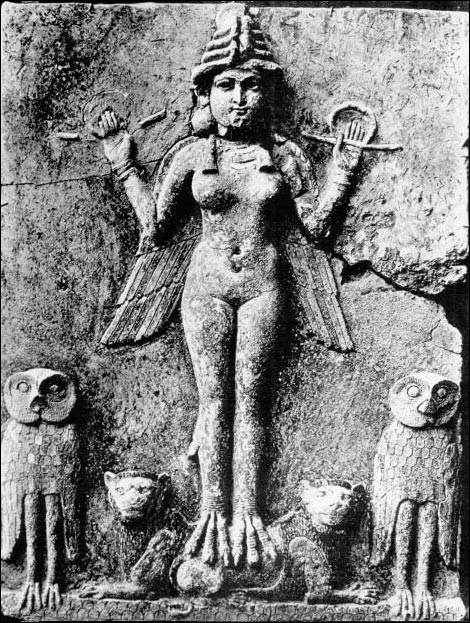 |
Lilith Origin The Ancient World : The Middle East : Old Babylonian Period : Return of Amorites to Babylonia : Time of Isin and Larsa Dynasties Summary This plaque, the so-called "Burney Plaque," depicts a highly composite Mesopotamian goddess, widely presumed to be a representation of "Lilith," a night hag or witch, a demoness associated in many cultures with nocturnal sexual visits during mens' dreams, and child stealing. Description The Burney Plaque has no archaeological provenance or context. It first appeared on the antiquities market and is now in private hands. These facts, combined with its atypical, composite, stylistically eccentric nature, have led some scholars to consider it inauthentic. However, there are outstanding authorities, such as Andre Parrot, who consider it authentic, and it is now widely illustrated as an authentic piece. Its date on stylistic grounds is assigned to the Old Babylonian period, about 1800-1600 B.C. It has two very distinctive Old Babylonian features, the horned headdress that identifies the figure as a goddess, and the symbols of divine authority that she holds in her hands. This object, which she appears to hold in both hands, is the staff and ring which can also be seen in Ishtar's hands, in the Investiture of Zimri-Lim of Mari. In that painting, Ishtar extends the staff and ring to King Zimri-Lim, bestowing her divine authority on his kingship. The same object can be seen in the hands of the god Shamash on the Hammurabi Stele, where Shamash extends the staff and ring to King Hammurabi. This goddess actually has other distinctive attributes of Ishtar. Her nakedness identifies her as a symbol of eroticism and fertility, and she stands on lions, the cult animal of Ishtar. But this goddess also has characteristics of the Anzu bird of Sumerian mythology: her wings and the claws that form her feet. The Anzu bird appears in a similar pose, digging its claws into the backs of lions, on early Sumerian plaques. The goddess pictured here stands on a representation of mountains. Ninhursag, the Sumerian mother goddess is known as the "mistress of the mountains," and her cult symbol is the Anzu bird, so we see on the Burney Plaque reminders of Ninhursag. The two owls that flank her legs introduce yet another feature that has been attached to a number of goddesses in various cultures. The Greek Athena had the owl as her cult bird and symbol, as did the Roman Minerva. Cultural Context By taking together the composite symbols of the Burney Plaque we can see a goddess embodying many traits: fertility, sexuality and divine power (Ishtar), awesome destructive power and a menacing presence (the Anzu bird), fertility and protective nurturing (Ninhursag), and wisdom, access to secret knowledge, death, and the underworld. The word Lilith, which appears in Sumerian, in Assyro-Babylonian cuneiform, and in Hebrew has at its root the meaning "wind." In Sumerian it was used with the meanings "phantom," "ghost," "haunting spirit." In both Sumerian and Assyro-Babylonian it referred to a kind of demon, either male or female, who would give men headaches and appear in dreams. Such demons were thought to be threatening to babies. The word appears in the Bible at Isaiah 34:14, and is translated as "screech owl" in the King James Version, but as "night hag" by a modern scholar. We can see the association between the Hebrew word and owls at the time of the early English Bible translations. Owls represent a range of qualities and symbols associated with its nocturnal nature, its screech and its piercing eyes that can see in the dark: death, supernatural wisdom, knowledge of mysteries. In the Classical world owls were the cult birds of Athena (because of the association with wisdom) and Roman Minerva (because of the association with ill luck and death). Here then, in the Burney Plaque, we have a composite figure representing characteristics that have been associated with many goddesses and mythological creatures. Taken together, these features define her as at once sexual, powerful, and malevolent. She is clear example of the type of violent goddess, well known in many of the worlds' religions: life giving and life taking, sexual and threatening, kindly yet terrifying. Another very striking feature of the plaque is its symmetrical, architectonic composition, in which the goddess forms the vertical center, and the lions and owls are arranged symmetrically on either side of her, forming a very well defined curving horizontal line, all of them resting on the straight horizontal of the mountains. Mountains usually represent temples in ancient Near Eastern symbolism, and lions often flanked the entrances of temples. It is almost certain that this plaque would have been placed in a temple, and the composite symbolism that has been suggested here would probably have focused temple devotees attention on it to invoke the goddesses' protection in order to ward off the evil powers associated with her. Image Sources As is on the short form. References Dunnigan, Ann. "Owls." The Encyclopedia of Religion. Ed. by Mircea Eliade. 11:144-145. Gaster, Theodor H. Myth, Legend and Custom in the Old Testament. New York: Harper and Row, 1969, pp. 578-580. Parrot, Andre. Sumer, The Dawn of Art. Transl. by Stuart Gilbert and James Emmons. New York: Golden Press, 1961, p.300. Preston, James J. "Goddess Worship: An Overview." The Encyclopedia of Religion. Ed. by Mircea Eliade. 6:43-44. |